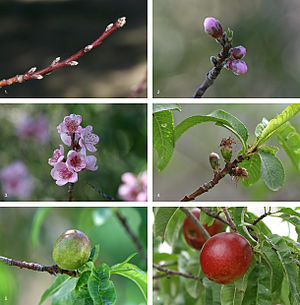- Drupe
-
 The development sequence of a typical drupe, a smooth-skinned (nectarine) type of peach (Prunus persica) over a 7 1⁄2 month period, from bud formation in early winter to fruit ripening in midsummer
The development sequence of a typical drupe, a smooth-skinned (nectarine) type of peach (Prunus persica) over a 7 1⁄2 month period, from bud formation in early winter to fruit ripening in midsummer
In botany, a drupe is a fruit in which an outer fleshy part (exocarp, or skin; and mesocarp, or flesh) surrounds a shell (the pit, stone or pyrene) of hardened endocarp with a seed inside. These fruits develop from a single carpel,[citation needed] and mostly from flowers with superior ovaries. The definitive characteristic of a drupe is that the hard, lignified stone (or pit) is derived from the ovary wall of the flower. In an aggregate fruit composed of small, individual drupes, each individual is termed a drupelet.
Other fleshy fruits may have a stony enclosure that comes from the seed coat surrounding the seed, but such fruits are not drupes.
Some flowering plants that produce drupes are coffee, jujube, mango, olive, most palms (including date, coconut and oil palms), pistachio, and all members of the genus Prunus, including the almond (in which the mesocarp is somewhat leathery), white sapote, apricot, cherry, damson, nectarine, peach, and plum.
Corking is a nutritional disorder in stone fruit caused by a lack of boron and/or calcium.[1]
Contents
Terminology
The term stone fruit (also stonefruit) can be a synonym for drupe or, more typically, it can mean just the fruit of the Prunus genus.
Freestone refers to a drupe having a stone which can be removed from the flesh with ease. The flesh is not attached to the stone and does not need to be cut to free the stone. Freestone varieties of fruits are preferred for uses that require careful removal of the stone, especially if removal will be done by hand. Freestone plums are preferred for making homegrown prunes, and freestone sour cherries are preferred for making pies and cherry soup.
Clingstone refers to a drupe having a stone which cannot easily be removed from the flesh. The flesh is attached strongly to the stone and must be cut to free the stone. Clingstone varieties of fruits in the genus Prunus are preferred as table fruit and for jams, because the flesh of clingstone fruits tends to be more tender and juicy throughout.
Tryma is a specialized term for such nut-like drupes that are difficult to categorize. Hickory nuts (Carya) and walnuts (Juglans) in the Juglandaceae family grow within an outer husk; these fruits are technically drupes or drupaceous nuts, and thus not true botanical nuts.[2][3]
Ecology
Drupes, with their sweet, fleshy outer layer, attract the attention of animals as a food, and the plant population benefits from the resulting dispersal of its seeds. The endocarp (pit or stone) is sometimes dropped after the fleshy part is eaten, but is often swallowed, passing through the digestive tract, and returned to the soil in feces with the seed inside unharmed. This passage through the digestive tract can reduce the thickness of the endocarp, and thus can aid in germination rates. The process is known as scarification.
Examples
Typical drupes include peaches, plums, and cherries (see pictures below).
The coconut is also a drupe, but the mesocarp is fibrous or dry (termed a husk), so this type of fruit is classified as a simple dry fruit, fibrous drupe. Unlike other drupes, the coconut seed is unlikely to be dispersed by being swallowed by fauna, due to its large size. It can, however, float extremely long distances across oceans.
Bramble fruits (such as the blackberry or the raspberry) are aggregates of drupelets. The fruit of blackberries and raspberries comes from a single flower whose pistil is made up of a number of free carpels. However, mulberries, which closely resemble blackberries, are not aggregate fruit, but are multiple fruits, actually derived from bunches of catkins, each drupelet thus belonging to a different flower.
Certain drupes occur in large clusters, as in the case of palm species, where a sizable array of drupes are found in a cluster. Examples of such large drupe clusters include Jubaea chilensis[4] in central Chile and Washingtonia filifera in the Sonoran Desert of North America.
Media
-
The peach is a typical drupe (stone fruit)
References
- ^ Day, Kevin (1999-01-27). "Peach and Nectarine Cork Spot:A Review of the 1998 Season". University of California, Davis. http://cetulare.ucdavis.edu/pubfruit/peach.htm. Retrieved 2010-04-01.
- ^ W.P. Armstrong. 2008. Identification Of Major Fruit Types
- ^ W.P. Armstrong. 2008. Fruits Called Nuts
- ^ C. Michael Hogan. 2008. Chilean Wine Palm: Jubaea chilensis, GlobalTwitcher.com, ed. N. Stromberg
External links
Types of fruits Types of fruits Categories of fruits Function Categories:- Fruit
- Plant morphology
- Edible nuts and seeds
Wikimedia Foundation. 2010.





